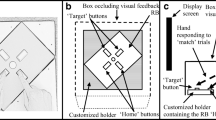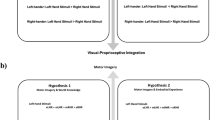Abstract
The common-coding hypothesis suggests that the more similar an observed action is to the way the observer would perform it, the stronger is the ensuing activation of motor representations. Therefore, producing actions could prime perception so that observers would be particularly responsive to (i.e. biased to perceive) actions that are related to, and share features with, their own actions. If this similarity principle also applies to handedness, right- and left-handers should be more likely to perceive actions as performed with their dominant rather than non-dominant hand. In two experiments, participants were required to indicate the perceived orientation (front or back view) of pictures of ambiguous human silhouettes performing one-handed manual actions. Experiment 1, in which 300 right-handers and 60 left-handers reported the orientation of a single silhouette seen for as much as they wished, showed that participants perceived the figures more frequently in an orientation congruent with a movement performed with the right rather than the left hand. Experiment 2, in which 12 right-handers and 12 left-handers reported the orientation of 52 silhouettes seen for 300 ms, showed similar results when multiple responses per participant were collected rather than only one. Contrary to our expectations, no difference was observed between right- and left-handers, which might suggest an attentional bias towards the right arm of human bodies in both groups. Moreover, participants were more likely to perceive the figure as front-facing than as back-facing, possibly due to the greater adaptive relevance of approaching compared to receding individuals.



Similar content being viewed by others
References
Abernethy B, Gill DP, Parks SL, Packer ST (2000) Expertise and the perception of kinematic and situational probability information. Perception 30:233–252
Abernethy B, Zawi K, Jackson RC (2008) Expertise and attunement to kinematic constraints. Perception 37:931–948
Aglioti SM, Cesari P, Romani M, Urgesi C (2008) Action anticipation and motor resonance in elite basketball players. Nat Neurosci 11:1109–1116
Berends HI, Wolkorte R, Ijzerman MJ, van Putten MJAM (2013) Differential cortical activation during observation and observation-and-imagination. Exp Brain Res 229:337–345
Bisiacchi PS, Ripoll H, Stein J, Simonet P, Azemar G (1985) Left-handedness in fencers: an attentional advantage? Percept Mot Skills 61:507–513
Blakemore S-J, Decety J (2001) From the perception of action to the understanding of intention. Nat Rev Neurosci 2:561–567
Buccino G, Binkofski F, Fink GR, Fadiga L, Fogassi L, Gallese V, Seitz RJ, Zilles K, Rizzolatti G (2001) Action observation activates premotor and parietal areas in a somatotopic manner: an fMRI study. Eur J Neurosci 13:400–404
Calvo-Merino B, Glaser DE, Grèzes J, Passingham RE, Haggard P (2005) Action observation and acquired motor skills. Cereb Cortex 15:1243–1249
Casile A, Giese MA (2006) Non-visual motor learning influences the recognition of biological motion. Curr Biol 16:69–74
Conson M, Mazzarella E, Trojano L (2011) Self-touch affects motor imagery: a study on posture interference effect. Exp Brain Res 215:115–122
Cross ES, Hamilton AF, Grafton ST (2006) Building a motor simulation de novo: observation of dance by dancers. NeuroImage 31:1257–1267
Dassonville P, Zhu X-H, Ugurbil K, Kim S-G, Ashe J (1997) Functional activation in motor cortex reflects the direction and the degree of handedness. Proc Natl Acad Sci USA 94:14015–14018
Doi H, Shinohara K (2012) Bodily movement of approach is detected faster than that of receding. Psychon Bull Rev 19:858–863
Faurie C, Raymond M (2005) Handedness, homicide and negative frequency-dependent selection. Proc Biol Sci 272:25–28
Gallese V (2003) The manifold nature of interpersonal relations: the quest for a common mechanism. Philos Trans R Soc Lond B Biol Sci 358:517–528
Gardner M, Potts R (2010) Hand dominance influences the processing of observed bodies. Brain Cogn 73:35–40
Gehlbach H, Barge S (2012) Anchoring and adjusting in questionnaire responses. Basic Appl Soc Psychol 34:417–433
Gentilucci M, Daprati E, Gangitano M (1998) Right-handers and left-handers have different representations of their own hand. Cogn Brain Res 6:185–192
Grafton ST, Arbib MA, Fadiga L, Rizzolatti G (1996) Localization of grasp representations in humans by positron emission tomography. 2. Observation compared with imagination. Exp Brain Res 112:103–111
Grèzes J, Decety J (2001) Functional anatomy of execution, mental simulation, observation, and verb generation of actions: a meta-analysis. Hum Brain Mapp 12:1–19
Grèzes J, Armony JL, Rowe J, Passingham RE (2003) Activations related to “mirror” and “canonical” neurones in the human brain: an fMRI study. NeuroImage 18:928–937
Grèzes J, Frith CD, Passingham RE (2004) Inferring false beliefs from the actions of oneself and others: an fMRI study. NeuroImage 21:744–750
Gursoy R (2009) Effects of left- or right-hand preference on the success of boxers in Turkey. Br J Sports Med 43:142–144
Hagemann N (2009) The advantage of being left-handed in interactive sports. Atten Percept Psychophys 71:1641–1648
Heenan A, Troje NF (2014) Both physical exercise and progressive muscle relaxation reduce the facing-the-viewer bias in biological motion perception. PLoS ONE 9:e99902
Hohmann T, Troje NF, Olmos A, Munzert J (2011) The influence of motor expertise and motor experience on action and actor recognition. J Cogn Psychol 23:403–415
Holtzen DW (2000) Handedness and professional tennis. Int J Neurosci 105:101–119
Hommel B, Müsseler J, Aschersleben G, Prinz W (2001) The theory of event coding (TEC): a framework for perception and action. Behav Brain Sci 24:849–937
Ionta S, Blanke O (2009) Differential influence of hands posture on mental rotation of hands and feet in right and left handers. Exp Brain Res 195:207–217
Ionta S, Fourkas A, Fiorio M, Aglioti SM (2007) The influence of hands posture on mental rotation of hands and feet. Exp Brain Res 183:1–7
Jacobs A, Pinto J, Shiffrar M (2004) Experience, context, and the visual perception of human movement. J Exp Psychol Hum Percept Perform 30:822–835
Jeannerod M (2001) Neural simulation of action: a unifying mechanism for motor cognition. NeuroImage 14:S103–S109
Johansson G (1973) Visual perception of biological motion and a model for its analysis. Percept Psychophys 14:201–211
Knoblich G, Flach R (2001) Predicting the effects of actions: interactions of perception and action. Psychol Sci 12:467–472
Knoblich G, Flach R (2003) Action identity: evidence from self-recognition, prediction, and coordination. Conscious Cogn 12:620–632
Knoblich G, Sebanz N (2006) The social nature of perception and action. Curr Dir Psychol Sci 15:99–104
Loffing F, Schorer J, Hagemann N, Baker J (2012) On the advantage of being left-handed in volleyball: further evidence of the specificity of skilled visual perception. Atten Percept Psychophys 74:446–453
Macuga KL, Frey SH (2012) Neural representations involved in observed, imagined, and imitated actions are dissociable and hierarchically organized. NeuroImage 59:2798–2807
Marzoli D, Mitaritonna A, Moretto F, Carluccio P, Tommasi L (2011a) The handedness of imagined bodies in action and the role of perspective-taking. Brain Cogn 75:51–59
Marzoli D, Palumbo R, Di Domenico A, Penolazzi B, Garganese P, Tommasi L (2011b) The relation between self-reported empathy and motor identification with imagined agents. PLoS ONE 6:e14595
Marzoli D, Menditto S, Lucafò C, Tommasi L (2013) Imagining others’ handedness: visual and motor processes in the attribution of the dominant hand to an imagined agent. Exp Brain Res 22:37–46
Marzoli D, Prete G, Tommasi L (2014) Perceptual asymmetries and handedness: a neglected link? Front Psychol 5:163
McMorris T, Colenso S (1996) Anticipation of professional soccer goalkeepers when facing right- and left-footed penalty kicks. Percept Mot Skills 82:931–934
Mechelli A, Price CJ, Friston KJ, Ishai A (2004) Where bottom-up meets top-down: neuronal interactions during perception and imagery. Cereb Cortex 14:1256–1265
Munzert J, Zentgraf K, Stark R, Vaitl D (2008) Neural activation in cognitive motor processes: comparing motor imagery and observation of gymnastic movements. Exp Brain Res 188:437–444
Nì Choisdealbha Á, Brady N, Maguinness C (2011) Differing roles for the dominant and non-dominant hands in the hand laterality task. Exp Brain Res 211:73–85
Parsons LM (1994) Temporal and kinematic properties of motor behaviour reflected in mentally simulated action. J Exp Psychol Hum 20:709–730
Raymond M, Pontier D, Dufour AB, Moller AP (1996) Frequency-dependent maintenance of left handedness in humans. Proc Biol Sci 263:1627–1633
Reithler J, van Mier HI, Peters JC, Goebel R (2007) Nonvisual motor learning influences abstract action observation. Curr Biol 17:1201–1207
Rizzolatti G, Fogassi L, Gallese V (2001) Neurophysiological mechanisms underlying the understanding and imitation of action. Nat Rev Neurosci 2:661–670
Salmaso D, Longoni AM (1985) Problems in the assessment of hand preference. Cortex 21:533–549
Schorer J, Loffing F, Hagemann N, Baker J (2012) Human handedness in interactive situations: negative perceptual frequency effects can be reversed! J Sports Sci 30:507–513
Schouten B, Troje NF, Brooks A, van der Zwan R, Verfaillie K (2010) The facing bias in biological motion perception: effects of stimulus gender and observer sex. Atten Percept Psychophys 72:1256–1260
Schütz-Bosbach S, Prinz W (2007) Perceptual resonance: action-induced modulation of perception. Trends Cogn Sci 11:349–555
Sebanz N, Shiffrar M (2009) Detecting deception in a bluffing body: the role of expertise. Psychon B Rev 16:170–175
Solodkin A, Hlustik P, Noll DC, Small SL (2001) Lateralization of motor circuits and handedness during finger movements. Eur J Neurol 8:425–434
Stelzl I (2000) What sample sizes are needed to get correct significance levels for log-linear models? A Monte Carlo study using the SPSS procedure “Hiloglinear”. Methods Psychol Res Online 5:95–116
Stokes M, Thompson R, Cusack R, Duncan J (2009) Top-down activation of shape-specific population codes in visual cortex during mental imagery. J Neurosci 29:1565–1572
Szameitat AJ, Shen S, Conforto A, Sterr A (2012) Cortical activation during executed, imagined, observed, and passive wrist movements in healthy volunteers and stroke patients. NeuroImage 62:266–280
Takeda K, Shimoda N, Sato Y, Ogano M, Kato H (2010) Reaction time differences between left- and right-handers during mental rotation of hand pictures. Laterality 15:415–425
Thornton IM, Vuong QC, Bülthoff HH (2003) A chimeric point-light walker. Perception 32:377–383
Tversky A, Kahneman D (1974) Judgment under uncertainty: heuristics and biases. Science 185:1124–1131
Van de Cruys S, Schouten B, Wagemans J (2013) An anxiety-induced bias in the perception of a bistable point-light walker. Acta Psychol 144:548–553
Vanrie J, Dekeyser M, Verfaillie K (2004) Bistability and biasing effects in the perception of an ambiguous point-light walker. Perception 33:547–560
Willems RM, Hagoort P (2009) Hand preference influences neural correlates of action observation. Brain Res 1269:90–104
Willems RM, Toni I, Hagoort P, Casasanto D (2009) Body-specific motor imagery of hand actions: neural evidence from right-and left-handers. Front Hum Neurosci 3:1–9
Willems RM, Hagoort P, Casasanto D (2010) Body-specific representations of action verbs: neural evidence from right- and left-handers. Psychol Sci 21:67–74
Williamson KE, Jakobson LS, Troje NF (2008) A right-facing bias in the processing of biological motion? J Vis 8:913
Ziyagil MA, Gursoy R, Dane Ş, Yuksel R (2010) Left-handed wrestlers are more successful. Percept Mot Skills 111:65–70
Acknowledgments
We thank Matteo D’Orazio for his help in collecting data.
Conflict of interest
The authors declare that they have no conflict of interest.
Author information
Authors and Affiliations
Corresponding author
Electronic supplementary material
Below is the link to the electronic supplementary material.
Rights and permissions
About this article
Cite this article
Marzoli, D., Lucafò, C., Pagliara, A. et al. Both right- and left-handers show a bias to attend others’ right arm. Exp Brain Res 233, 415–424 (2015). https://doi.org/10.1007/s00221-014-4124-5
Received:
Accepted:
Published:
Issue Date:
DOI: https://doi.org/10.1007/s00221-014-4124-5




